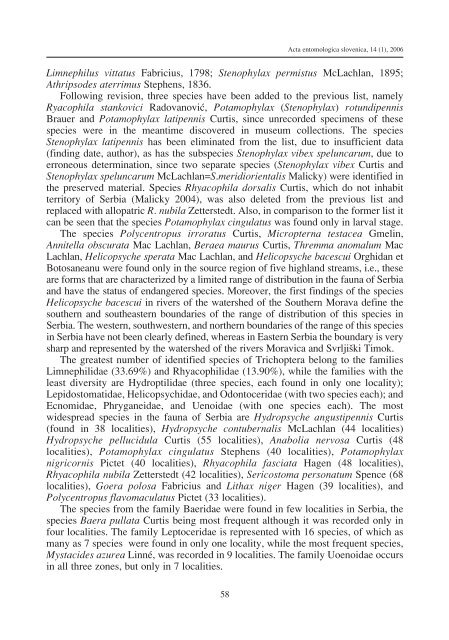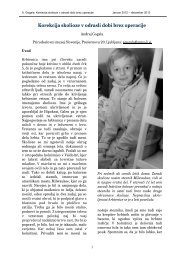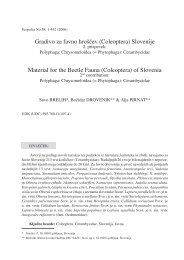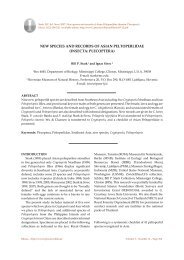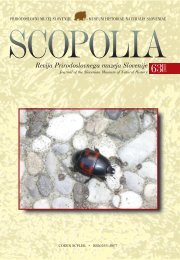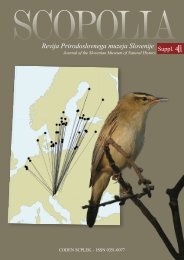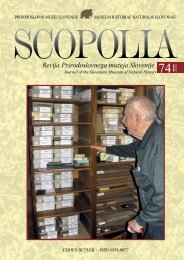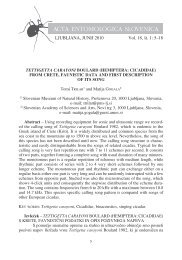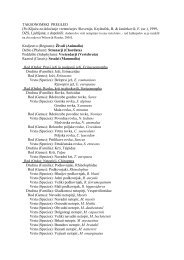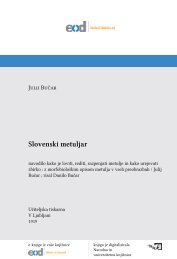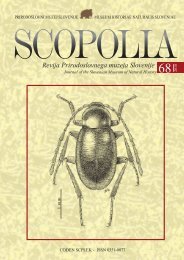Vsebina / Content (.pdf) - Prirodoslovni muzej Slovenije
Vsebina / Content (.pdf) - Prirodoslovni muzej Slovenije
Vsebina / Content (.pdf) - Prirodoslovni muzej Slovenije
- No tags were found...
Create successful ePaper yourself
Turn your PDF publications into a flip-book with our unique Google optimized e-Paper software.
Acta entomologica slovenica, 14 (1), 2006Limnephilus vittatus Fabricius, 1798; Stenophylax permistus McLachlan, 1895;Athripsodes aterrimus Stephens, 1836.Following revision, three species have been added to the previous list, namelyRyacophila stankovici Radovanoviå, Potamophylax (Stenophylax) rotundipennisBrauer and Potamophylax latipennis Curtis, since unrecorded specimens of thesespecies were in the meantime discovered in museum collections. The speciesStenophylax latipennis has been eliminated from the list, due to insufficient data(finding date, author), as has the subspecies Stenophylax vibex speluncarum, due toerroneous determination, since two separate species (Stenophylax vibex Curtis andStenophylax speluncarum McLachlan=S.meridiorientalis Malicky) were identified inthe preserved material. Species Rhyacophila dorsalis Curtis, which do not inhabitterritory of Serbia (Malicky 2004), was also deleted from the previous list andreplaced with allopatric R. nubila Zetterstedt. Also, in comparison to the former list itcan be seen that the species Potamophylax cingulatus was found only in larval stage.The species Polycentropus irroratus Curtis, Micropterna testacea Gmelin,Annitella obscurata Mac Lachlan, Beraea maurus Curtis, Thremma anomalum MacLachlan, Helicopsyche sperata Mac Lachlan, and Helicopsyche bacescui Orghidan etBotosaneanu were found only in the source region of five highland streams, i.e., theseare forms that are characterized by a limited range of distribution in the fauna of Serbiaand have the status of endangered species. Moreover, the first findings of the speciesHelicopsyche bacescui in rivers of the watershed of the Southern Morava define thesouthern and southeastern boundaries of the range of distribution of this species inSerbia. The western, southwestern, and northern boundaries of the range of this speciesin Serbia have not been clearly defined, whereas in Eastern Serbia the boundary is verysharp and represented by the watershed of the rivers Moravica and Svrljiøki Timok.The greatest number of identified species of Trichoptera belong to the familiesLimnephilidae (33.69%) and Rhyacophilidae (13.90%), while the families with theleast diversity are Hydroptilidae (three species, each found in only one locality);Lepidostomatidae, Helicopsychidae, and Odontoceridae (with two species each); andEcnomidae, Phryganeidae, and Uenoidae (with one species each). The mostwidespread species in the fauna of Serbia are Hydropsyche angustipennis Curtis(found in 38 localities), Hydropsyche contubernalis McLachlan (44 localities)Hydropsyche pellucidula Curtis (55 localities), Anabolia nervosa Curtis (48localities), Potamophylax cingulatus Stephens (40 localities), Potamophylaxnigricornis Pictet (40 localities), Rhyacophila fasciata Hagen (48 localities),Rhyacophila nubila Zetterstedt (42 localities), Sericostoma personatum Spence (68localities), Goera polosa Fabricius and Lithax niger Hagen (39 localities), andPolycentropus flavomaculatus Pictet (33 localities).The species from the family Baeridae were found in few localities in Serbia, thespecies Baera pullata Curtis being most frequent although it was recorded only infour localities. The family Leptoceridae is represented with 16 species, of which asmany as 7 species were found in only one locality, while the most frequent species,Mystacides azurea Linné, was recorded in 9 localities. The family Uoenoidae occursin all three zones, but only in 7 localities.58


